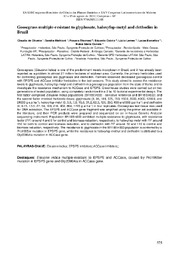Goosegrass multiple-resistant to glyphosate, haloxyfop-metyl and clethodim in Brazil.
Goosegrass multiple-resistant to glyphosate, haloxyfop-metyl and clethodim in Brazil.
Author(s): OLIVEIRA, C. de; MATHIONI, S.; THOMASI, R.; OZÓRIO, E.; LEMES, L.; BARCELLOS, L.; CORREIA, N. M.
Summary: Goosegrass (Eleusine indica) is one of the predominant weeds in soybean in Brazil, and it has already been reported as a problem in almost 27 million hectares of soybean area. Currently, the primary herbicides used for controlling goosegrass are glyphosate and clethodim. Farmers observed decreased goosegrass control with EPSPS and ACCase inhibitor herbicides in the last seasons. This study aimed to assess the resistance levels to glyphosate, haloxyfop-metyl and clethodim in a goosegrass population from the state of Bahia and to investigate the resistance mechanism to ACCase and EPSPS. Greenhouse studies were carried out on two generations of tested population, using completely randomized in a 2 by 10 factorial experimental design. The first factor comprised Eleusine indica populations (BR18Ein000 - sensitive reference and BR18Ein033) and the second factor involved herbicide doses: glyphosate (0, 94, 188, 375, 750, 1500, 3000, 6000, 12000, and 24000 g e.a ha-1), haloxyfop-metyl (0, 3.9, 7.8, 15.6, 31.2, 62.3, 125, 250, 499 and 998 g ai ha-1) and clethodim (0, 6.75, 13.5, 27, 54, 108, 216, 432, 864, 1728 g ai ha-1) in four replicates. Goosegrass leaf tissue was used for DNA extraction. The EPSPS and ACCase gene fragment was amplified using the primer set available in the literature, and then PCR products were prepared and sequenced on an in-house Genetic Analyzer sequencing instrument. Population BR18Ein033 exhibited multiple-resistance to glyphosate, with resistance factor (RF) around 4 and 6 for control and biomass reduction, respectively, to haloxyfop-metyl with RF around 150 for both to control and biomass reduction, and to clethodim with RF around 50 and 110 to control and biomass reduction, respectively. The resistance to glyphosate in the BR18Ein033 population is conferred by a Pro106Ser mutation in EPSPS gene, while the resistance to haloxyfop-methyl and clethodim is attributed to a Gly2096Ala mutation in ACCase gene.
Publication year: 2024
Types of publication: Abstract in annals or event proceedings
Unit: Embrapa Cerrados
Keywords: Clethodim, Eleusine indica, Glyphosate, Haloxyfop, Herbicides
Observation
Some of Embrapa's publications are published as ePub files. To read them, use or download one of the following free software options to your computer or mobile device. Android: Google Play Books; IOS: iBooks; Windows and Linux: Calibre.
Access other publications
Access the Agricultural Research Database (BDPA) to consult Embrapa's full library collection and records.
Visit Embrapa Bookstore to purchase books and other publications sold by Embrapa.

